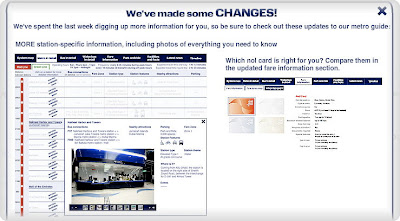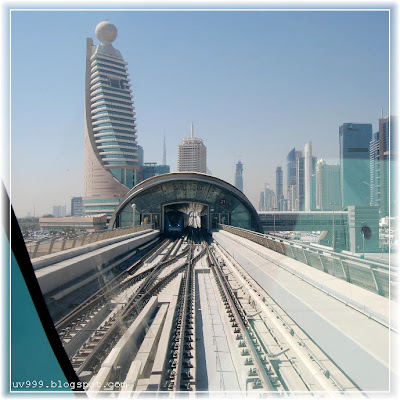(Dubai) It's 9:30 pm. The side street I'm on, a little off of a main road, has a line of street lights but it is still rather dark. I sit alone in a brightly lit bus shelter in an area where there are a few office blocks and some activity in a nearby parking lot. I am usually the only passenger in the bus shelter this time of night and I sit waiting with my white Macintosh laptop open, as I try to read or type while watching out for the bus.

Financial Center metro station at night.
(Seattle, USA) I'm a tourist there, unfamiliar with just about everything. It's 5:30 pm, the sun has just set, but it's still light out. I stand nervously at the downtown bus stop. It's on a major road but a bit on the edge of the CBD (central business district). Why does the whole area seem so eerily deserted still early in the evening? I'm empty handed, carrying nothing thankfully, but I just wish the bus would hurry up and come. There are a few dodgy looking characters making their way toward me. Someone's high I can tell. Let me somehow just be inconspicuous.
I don't think it would be exaggerating to say that I would never, ever sit at a lonely bus stop in any American city blithely pecking at keys on my laptop. If I dared even to carry a laptop I would do my best to disguise it and appear as nonchalant and local as I possibly could.
 A typical interior in many of Dubai's new, uncrowded buses. >>
A typical interior in many of Dubai's new, uncrowded buses. >>In Dubai I feel 100% safe and at ease in such a setting, but in most American cities under similar circumstances I would feel absolutely at risk and vulnerable. It is the combination of dusk or nightfall and the absence of pedestrian traffic, save any miscreants, that can turn an otherwise normal functioning city street into a lawless no-man's land.
Americans and the local residents know this. They know that it matters what the time of day is, what the pedestrian traffic is like and what other conditions are there that might make a street unsafe.
Is it a justified rationale that they have or is it paranoia? Nothing happened to me at that Seattle bus stop as daylight faded. Nothing happened to me when I walked the dark streets of a New Orleans, still Katrina ravaged street, looking for a bus stop one night. But something could have or just might have happened--in a wrong place/wrong time kind of way.
I developed the perception growing up in America that the most unsafe thing one could do when in such a setting was to look like you didn't know where you were. To seem at ease and to somewhat blend in was the first rule. The second was to get out of that place as quickly as possible--without haste, that is, lest you violate the first rule.
I think this is the rule of thumb for most Americans. Whether it really is the answer to being safe or whether it is largely a matter of luck, I'm not quite sure. Whatever the case, I feel no need to be on my guard when on the streets of Dubai, whether by day or night.
Keeping it Real... Safe
 << A military style young Emirati security man.
<< A military style young Emirati security man.Security inside the Dubai metro is tight. There are two classes of uniformed men (I haven't seen any female security staff)--one in the popular Group 4 style and the other in military style garb. The former tend to include various expat staff and the latter young locals. There is also a contingent of station attendants wearing blazers or jackets of one kind or other.
It would seem the task of the attendants is to assist passengers and inspect their boarding cards, while the Group 4 style security men are there to enforce rules. The military style men don't normally interact with the passengers, so it would seem their role is to guard against terrorism and control the peace should the need arise. They do not, however, appear to carry any weapons except for batons.
I did attempt to engage one of the young officers in conversation. I was able to confirm that he was local, from Sharjah. He appeared to be very young, probably not yet 20, and he could not speak any English. Although I hadn't spoken with any of the other officers on duty, I would speculate that his profile was typical. They all seem to be local and as young as he was, and judging from their glances askance whenever I pass near any of them, I suspect most don't speak English.
Are the uniformed men, without weaponry really enough to guard against terrorism? One must appreciate that here there is no gun culture, except perhaps as part of some traditional dances. Security guards are always unarmed and I don't ever recall seeing a police officer carrying a pistol, although I may just never have noticed.
 A Group Four style civilian security man. >>
A Group Four style civilian security man. >>That said, I have heard that there is a new stipulation in Dubai that security guards must receive some kind of weapons training. Up till now the common practice seems to have been to simply put a uniform on a new man fresh off the boat and thus you get a qualified security man.
That begs the question once again. Are these security men enough to guard against terrorism? Well, they are at least eyes on the ground, and there are a lot of them roaming around the stations and on the trains themselves. There are also the much heralded CCTV cameras. That should be enough to spot the unattended bag or strangely behaving commuter. If they can keep an eye out for things suspicious as well as they manage to keep people from eating, drinking and entering the wrong cabins, then we shouldn't have too many security concerns.
All Alone
My commute to work today is a little earlier than usual, just turning noon. It finds me in the gold class all alone except for the company of a train attendant. This time must be the sweet spot where hardly anyone rides. Alas I am joined by a couple of other riders. Oh no, they've just been escorted to a silver class cabin.



















































